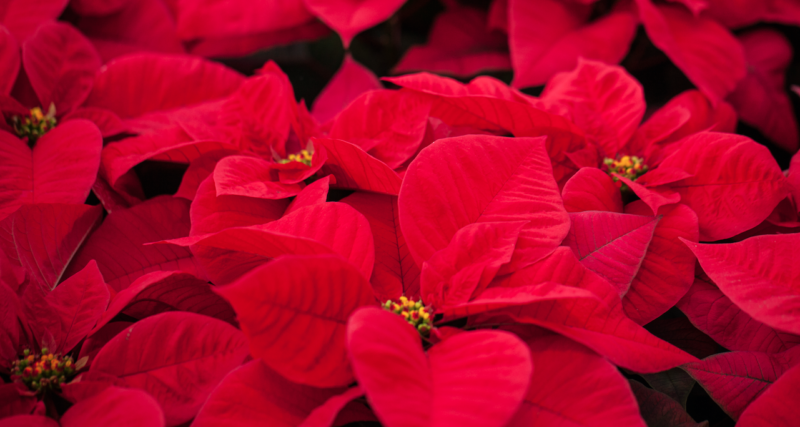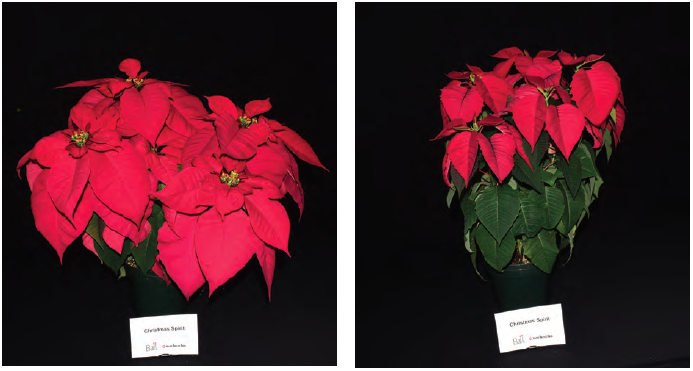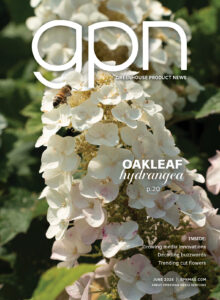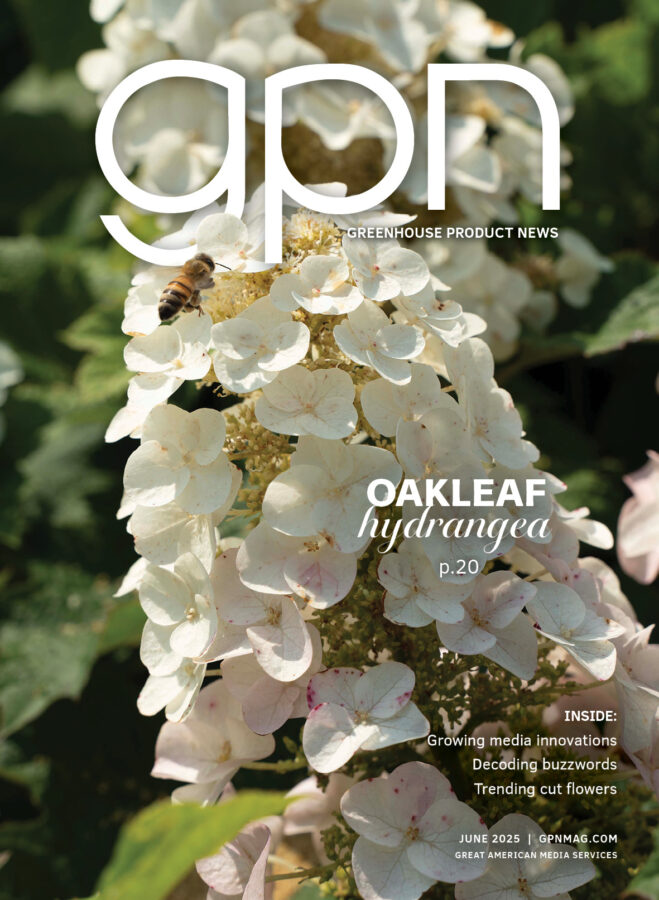
Heat Delay in Poinsettias
The 2018 fall season experienced high temperatures in some parts of the U.S., which caused heat delay of poinsettia flowering by up to several weeks in sensitive cultivars. Warm temperatures meant that plants were not in color for the intended market date, resulting in lost sales. Within floriculture businesses, poinsettias help pay down overhead costs, retain staff and help with cash flow in the fall. Because poinsettias are long-term crops with low margins, when plants are not ready to ship their profitability can be quickly lost. This article describes the physiology of heat delay, temperature conditions that affect risk and strategies to cope with this issue.
BIOLOGY OF HEAT DELAY
Figure 1 shows ‘Christmas Spirit’ as an example from the University of Florida cultivar trial in 2018. Plants were grown in greenhouses under natural day lengths under two temperature regimes from Sept. 1 to Nov. 1, and in the same greenhouse before and after this period. Remember, 2018 was a warm year; so even “normal” was very warm (87° F day, 75° F night, 80° F average during September and October), while the heat delay greenhouse was a scorching 92° F day, 80° F night and 85° F average.
‘Christmas Spirit’ was slightly less sensitive to heat delay than average when compared with the other 24 varieties tested from four breeders under these conditions. Averaged across varieties, first bract color and visible flower bud stages were delayed by approximately three weeks. Figure 1 shows the typical larger bracts and leaves, more mature flowers, greater branching, and better growth form for plants grown under normal compared with heat delay conditions.

Short-day plants such as poinsettia initiate flowering in response to long nights, meaning that flower buds (rather than leaves) form at the tiny meristems where cells divide at the tips of branches. This change from vegetative to reproductive growth occurs in response a dark (night) period of more than ≈12 hours over a period of about four to eight days, and can be observed under a microscope after about seven days. Flowers develop on a normal schedule if about five weeks of short days are provided, and short-day conditions naturally occur in the U.S. during September.
However, flower initiation in many short-day plants, including poinsettia, chrysanthemum, kalanchoe and schlumbergera, is delayed by warm temperatures, especially during the night period. Research at University of Florida by Rebecca Schnelle and Jim Barrett found that flower initiation in poinsettias was delayed when average daily temperature (ADT) was 80° F for more than a week during the short day period, compared with flowering when ADT was 70 to 75° F. Rob Berghage and Royal Heins at Michigan State University found that night temperatures (NT) above 73° F also delayed flower initiation in poinsettia.
Breeders are actively selecting genotypes that have reduced sensitivity to heat delay. Technical specialists base their evaluation of cultivars on observations of flowering time in multiple trial locations around the U.S.
Genotypes that flower early in the fall are also selected by breeders. Early flowering results from a combination of a plant initiating flowers under a short critical night length (early in the fall), and also a short response time from flower initiation to open blooms (the flower development period when bract expansion occurs). However, “early season” varieties are not necessarily less sensitive to warm temperature. For example, ‘Early Prestige Red’ is an early flowering variety that is sensitive to heat delay.
CLIMATE VARIABILITY AND TRENDS
We analyzed historical fall weather conditions in Florida to illustrate how climate is changing, and to show how temperature data can be interpreted in terms of heat delay risk. Climate data were downloaded from the Florida Automated Weather Network FAWN (https://fawn.ifas.ufl.edu) for five outdoor weather stations around the Florida peninsula. The main University of Florida campus is in Alachua County. Air temperatures collected at 2 meters outdoors were analyzed from 2004 to 2018.
We used two indicators of heat delay risk of poinsettia for climate between Sept. 1 to Oct. 1 each year to evaluate risk of heat delay. These were:
(A) Number of days when average daily temperature
(ADT) was 80° F or above, and
(B) Number of days when the minimum night temperature
(NT) was 74° F or above.
The 2018 season was at high risk for heat delay in terms of both ADT and NT in all locations in Florida (Table 1). Every year, Homestead, Florida, shows high risk conditions.
There is an increasing risk of heat delay when several days of either of these conditions occur in the month after short days begin. The risk continues to increase as temperatures increase above an ADT of 75° F or a NT of 73° F during this flower initiation period. Some heat delay may therefore occur even if your temperatures are not as extreme as those in Table 1.
STRATEGIES TO MANAGE HEAT DELAY RISK
• Select varieties that are fairly resistant to heat delay. Ask your breeder supplier for their recommendations, which for southern areas include:
→ ‘Christmas Beauty Red’, ‘Christmas Joy Red’, ‘Christmas Magic’, ‘Christmas Spirit’ and ‘Christmas Wish’ (Ball/Selecta)
→ ‘Aries’, ‘Astro’ and ‘Robyn’ (Beekenkamp)
→ ‘Advent’, ‘Ferrara’, ‘Premium Red’, ‘Red Soul’ and ‘Tikal’
(Dümmen Orange)
→ ‘Aria Red’, ‘Orion Early Red’, ‘Majoris Red’, ‘Mars Early Red’ and ‘Orion Red’ (Syngenta Flowers)
• Keep good records each year for each variety in your greenhouse, especially recording the date of first bract color (usually ≈4 weeks after start of short days), visible flower bud (≈5 weeks), and shippable plant (≈7 to 10 weeks) for each of your varieties.
• Take weekly photos of your crop from late September onward to have a visual reference for subsequent years (Figure 2).
• Track temperatures inside your greenhouse, especially during September. If possible, cool the greenhouse to have an ADT below 80° F and NT below 74° F. If you have a week or more of high temperatures during this period, start planning ahead for possible shipping delays.
• If heat delay has occurred in September and October, keep
temperatures warm (75° F ADT and NT at <73° F) during the bract and flower development period from mid-October through November to help flowers develop as quickly as possible.
• Consider growing poinsettias under black cloth to provide longer night lengths (14 hours) than those that occur naturally in September and October. Poinsettias will be less susceptible to heat delay when grown under longer night lengths provided that temperatures under the curtains are not excessive.

With increasing variability in fall weather, reduce the risk of heat delay by following breeder recommendations for varieties that have reduced heat sensitivity and grow well in your area. By keeping a close eye on crop development and temperature during September, you can evaluate the risk of delayed shipments from heat delay.
Acknowledgements: We thank Ball/Selecta, Beekenkamp, Dümmen Orange, Syngenta Flowers, and industry partners in the Floriculture Research Alliance (www.floriculturealliance.org) for supporting poinsettia trials at University of Florida.









 Video Library
Video Library 


















